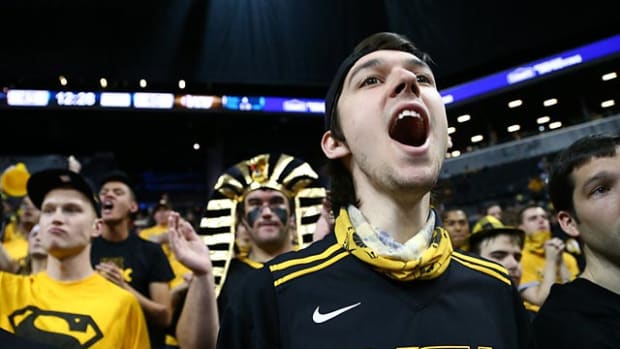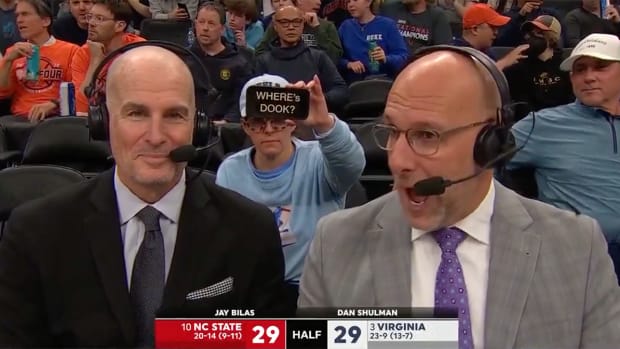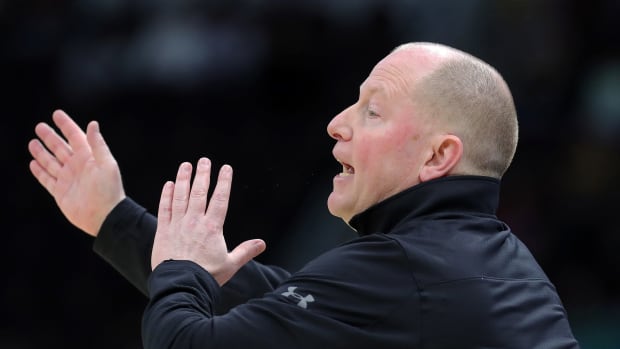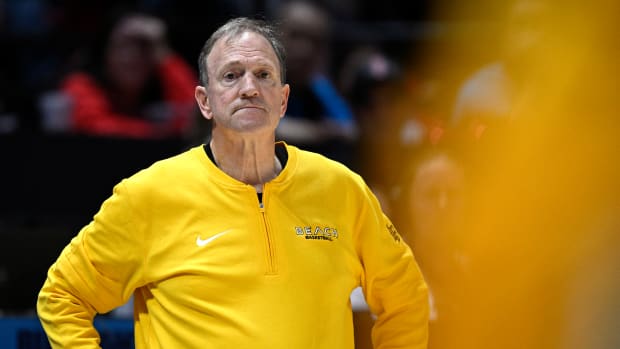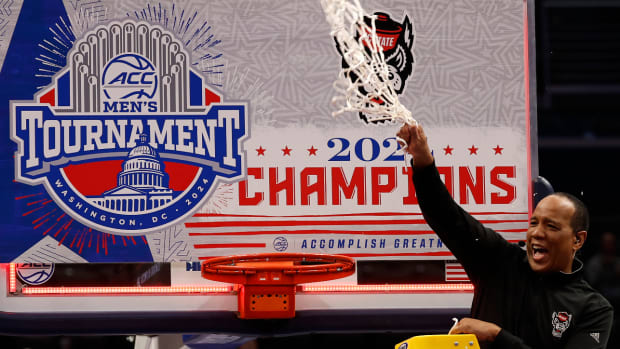NCAA President Charlie Baker Pushing Plan to Spread the Wealth Among College Athletes
Charlie Baker stood on the field at Lynn Family Stadium in Louisville, Ky., on Monday night, 30 minutes before Clemson defeated Notre Dame 2–1 for the NCAA Division I men’s soccer championship. The president of the NCAA spent last week putting the college sports establishment on notice that change is coming—structurally, monetarily, even philosophically.
But Baker’s presence here, in and of itself, could be construed as a tacit statement that his bold proposal for a new college athletics model is not meant to sacrifice Olympic sports on the gilded altar of football and basketball.
“I’m very anxious to make sure that when we come out of this, we don’t lose all the sports that are the so-called non-revenue-producing sports,” Baker said in an interview with Sports Illustrated. “I want those to continue to be a big part of the show. But at the same time, we’ve got to recognize—especially at the highest-resourced institutions—more has got to be done here.”
Part of doing more would be creating a new subdivision of Division I which would allow schools to pay 50 percent of their athletes a minimum of $30,000 a year—some of them considerably greater sums than that. That would, by necessity, mean paying more Olympic sports athletes.
Bringing NIL compensation in-house, and away from third-party collectives, is a tricky part of the overall plan. So is figuring out how those books are balanced, and how many schools can afford it. But the proposal would make paying women athletes and Olympic-sport athletes non-negotiable.

Baker has expressed an desire for more NIL funds to be funneled to non-revenue sports such as softball.
Bryan Terry/USA TODAY Network
“If you look where almost all the NIL money goes so far, it almost all goes to football and men’s basketball,” Baker said. “There are some real superstars in women’s sports doing very well, but they’re the exceptions to the rule. Part of the point behind bringing both the NIL piece into the school and creating some sort of structured, enhanced benefit for student-athletes at the school, they have to play by the Title IX rules. Which, in my opinion, means a broader distribution of financial support for both men and women and for more sports than just the ones that are traditionally the beneficiaries.”
Baker said he wants to see more athletes from more sports being compensated while also maintaining the big-tent championship access of Division I. While creating another subdivision might further differentiate the haves from the have-nots, the goal is not to eliminate smaller-budget schools from being able to compete for national titles.
To the contrary, the proposal is an attempt to keep everyone together. Specifically, to maintain the populist, David-vs.-Goliath appeal of the NCAA basketball tournaments.
“I think what makes college sports great, especially at the D-I level, is that weird things happen,” Baker said. “We should never lose that. It’s part of the beauty of it all. You think about March Madness last year, the four schools at the Final Four—one of them (Florida Atlantic) had only been a school for like 25 years. And then San Diego State.
“I think we all get the fact that there are going to be, for the most part, the schools with the biggest investments are going to be the most represented. Fine. But then you’re going to have a kid from Harvard win the cross country championship. That’s the beauty of it.”
With college sports besieged by legal threats while trying to maintain antitrust protection and avoid employee-employer relationships with its athletes, Baker and other industry leaders have lobbied Congress persistently. His proposal has been seen by many within the space as a message to legislators that the NCAA is willing to take the lead if Congress is willing to climb onboard.
Baker did not dispute that notion, acknowledging that college sports has to be proactive. The former governor of Massachusetts brings a greater political savvy to the NCAA president’s position than any of his predecessors.
“I’m working on the theory that not just people in Congress, but people in and around college sports, who would like to see the NCAA chart a course here, create a direction,” he said. “I certainly heard from a lot of the folks I talked to who said, ‘You all need to be forward-facing if we’re going to make progress here.’ Which I understand.”

Baker spoke to Congress in October about the NIL issues facing college sports and lobbied for more collaboration with the government.
Jack Gruber/USA TODAY
As for the reaction to Baker’s proposal within the college sports space, it has achieved its goal. It has sparked conversation and elicited additional ideas. Despite some public protestation from college sports leaders that they were not given any warning the proposal was coming, it’s hard to say they weren’t consulted—Baker spent much of this, his first year on the job, on a listening tour that included conversations with all 97 NCAA conferences.
“As I said to everybody about this, I view this [proposal] as a conversation starter,” Baker said. “The world I came out of, you want to start a conversation, make a proposal. Now everybody gets to have at it. What I will say, there is a fair amount of enthusiasm for the having at it, which is good. I hope that in some relatively reasonable period of time, we can make some progress on that stuff. Because it’s pretty clear that this is something people care about and think we should do something about.
“One of the best parts of this, I’ve already had people reach out to me and say, ‘What about doing this instead?’ The one thing I said to people when I was talking to them, I said, ‘Don’t say no.’ People have already started to take that idea and propose alternatives to it—which is fine. That’s kind of the whole purpose of it. I’ve seen very little pushback. The big message from almost everybody was, ‘Thank God we’re finally talking about the elephant in the room.’“
Baker refrained from talking about specific alternatives that have been broached, asking to “give me a couple weeks on that.” But he said the groundwork already laid by the NIL Working Group chaired by Florida deputy athletic director Lynda Tealer could help yield results on that front this month.
“It looks like we’re going to have a pretty decent NIL policy coming out of the folks on the D-I board and the working group by the end of the year,” said Baker, whose impactful first year on the job has served as a refutation that the NCAA president is a powerless position within an inert organization.
After the men’s soccer championship, Baker was due to make the 110-mile drive north to Indianapolis and NCAA headquarters for a few days. From there, his schedule for the weekend is brisk: the Division III football championship (the Amos Alonzo Stagg Bowl) in Virginia on Friday; the Celebration Bowl between HBCU schools Howard and Florida A&M in Atlanta on Saturday; and the D-I women’s volleyball championship game in Tampa Sunday.
“It’s this wonderful little perk that comes with the job,” Baker said. “Watching the kids play is great. Getting the chance to talk to them is the best part of all. The time I spend with student-athletes makes me feel a lot better about the state of the country, to tell you the truth. As a guy who came out of government and politics, you can get pretty depressed.”

